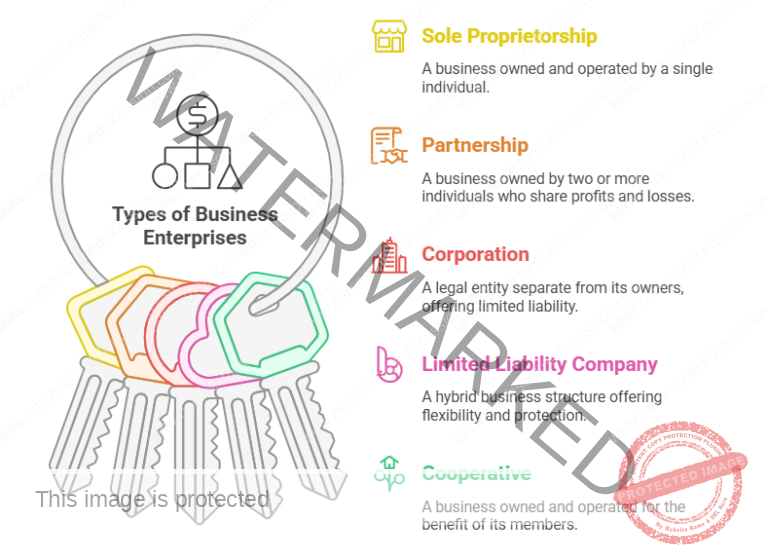Creating an Entrepreneurial Small Business
Subtopic:
Types/forms of business Enterprises

When starting a venture, an entrepreneur needs to decide on the organizational structure for the business. Business operations can be structured at an individual level or within a group framework.
Available options include:
Sole Proprietorship: A business owned and managed by a single person.
Company: A legally recognized entity, separate from its owners.
Partnership: A business owned and run by two or more individuals.
Cooperatives: Organizations owned and operated for the benefit of their members.
Other Forms: Various additional structures are also possible.
Sole Proprietorship

This is a business structure owned and run by a single individual. Often the simplest and most common business type, particularly in regions like Uganda. The owner faces unlimited liability, meaning their personal assets are at risk for business debts. Essentially, the owner and the business are legally the same entity. Family members may or may not assist in the business operations.
Examples:
A small, individually owned local convenience store.
A motorcycle taxi (bodaboda) service operated by the bike’s owner.
Advantages of a Sole Proprietorship
Swift Decision-Making: Owners can make fast choices independently, capitalizing quickly on market opportunities and changes.
Simple Startup: Establishing this business form is straightforward, requiring minimal legal procedures and paperwork. Often, only a basic business license is needed to commence operations.
Direct Profit Incentive: All business profits go directly to the owner, acting as a strong personal motivation to enhance business performance and earnings.
Adaptability: Sole proprietorships are highly flexible and can readily adjust to shifting market demands or conditions. Owners can easily modify offerings or enter new markets as needed.
Reduced Regulatory Burden: Compared to larger corporations, sole proprietorships typically face fewer governmental regulations, simplifying administration and lowering compliance costs.
Personalized Customer Interaction: Direct engagement with customers allows owners to build strong relationships and offer tailored service, fostering customer loyalty and potentially boosting sales.
Straightforward Management: Usually smaller in scale, these businesses are generally easy to oversee, with the owner maintaining direct control over all business aspects. This can minimize the need for complex organizational structures.
Cost-Effective Operation: Owners often avoid payroll expenses if they operate alone or with family help, leading to potentially lower operational costs and improved profitability.
Strategic Location Choice: Owners can select business locations based on customer convenience, improving accessibility to products or services.
Disadvantages of a Sole Proprietorship
Unlimited Personal Liability: A major drawback is that the owner is personally responsible for all business debts. Personal assets can be claimed to settle business obligations if the business cannot meet its financial responsibilities.
Potential for Isolated Decision Errors: Lack of consultation can lead to less informed or potentially flawed decisions, negatively impacting the business.
Risk of Overwork and Stress: Running a business alone can lead to long working hours, increased pressure, and potential burnout for the owner.
Challenges in Securing Funding: Obtaining loans might be difficult due to limited collateral and the perceived higher risk associated with single-person businesses by financial institutions.
Business Continuity Concerns: The business’s survival is directly linked to the owner. Incapacity or death of the owner can lead to business closure.
Limited Capital Resources: Investment and expansion are often restricted due to the owner’s personal financial limitations, potentially hindering growth.
Difficulty Attracting Skilled Staff: Sole proprietorships may find it hard to compete with larger businesses in attracting and keeping qualified employees due to potentially limited salary and benefit offerings.
Restricted Access to Resources: Owners might face challenges in accessing vital resources such as advanced technology, specialized expertise, and professional networks, which can put them at a disadvantage compared to larger competitors.
Get in Touch
(+256) 790 036 252
(+256) 748 324 644
Info@nursesonlinediscussion.com
Kampala ,Uganda
© 2025 Nurses online discussion. All Rights Reserved Design & Developed by Opensigma.co

